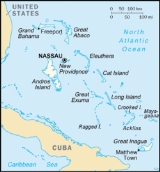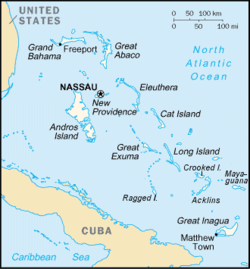
Ragged Island
Encyclopedia

Districts of the Bahamas
Local government in the Bahamas exists in two forms, namely second-schedule and third-schedule district councils. There are a total of 32 local government districts: 13 second-schedule districts, which are further sub-divided into town areas, and 19 third-schedule districts, which are all unitary...
in the southern Bahamas.
Until recently it had an active salt
Salt
In chemistry, salts are ionic compounds that result from the neutralization reaction of an acid and a base. They are composed of cations and anions so that the product is electrically neutral...
industry, the salt ponds having been developed in the 19th Century by a Mr. Duncan Taylor, after whom Duncan Town, the only settlement, is named.
The island was badly affected by Hurricane Donna
Hurricane Donna
Hurricane Donna in the 1960 Atlantic hurricane season was a Cape Verde-type hurricane which moved across the Leeward Islands, Puerto Rico, Hispanola, Cuba, The Bahamas, and every state on the East Coast of the United States...
and there has been a gradual emigration to more prosperous islands such as New Providence
New Providence
New Providence is the most populous island in the Bahamas, containing more than 70% of the total population. It also houses the national capital city, Nassau.The island was originally under Spanish control following Christopher Columbus' discovery of the New World, but the Spanish government showed...
. The population of Ragged Island in the 2000 census was just 72.
Fishermen say that the best bone fishing can be found on the Ragged Island.
Ragged Island is part of the Jumentos Cays and Ragged Island Chain. The croissant-shaped chain measures over 110 miles in length and includes cays known as Raccoon Cay, Hog Cay and Double-Breasted Cay.
Duncan Town is the only settlement in the entire chain and is situated within a bay of shallow water. The island relies on the "mail boat" for transportation to and from the major islands, as well as for freight and commerce. The island contains a small air strip and a harbor.
Most of the inhabitants are the direct descendants of the original settlers and they bear their original family names, such as Curling, Lockhart, Maycock, Moxey, Munroe, Wallace, and Wilson. The familiar heritage and their remoteness have resulted in the islands being part of the “family islands” or “out island”.
Although the island is remote and sparsely populated, many of its descendants have taken important roles within politics, athletics, entertainment and business.
Infrastructure
Communications
In August 2005, a contract was signed with TYCO International to deploy a fiber optic submarine cable in a self-healing ring topology, connecting 14 islands of the Bahamas; namely, New Providence, Andros, Eleuthera, Exuma, Long Island, Ragged Island, Inagua, Mayaguana, San Salvador, Rum Cay, Cat Island, Abaco, Crooked Island and Grand Bahama, at a cost of $60 Million.
Transportation
Airport - Upgrades to the Duncan Town Airport Ragged Island (funded by the European Union) were commenced in 2006, at a cost of $650,000.
Dock/dredging - The dredging and the building of a dock in Ragged Island commenced in 2006, at an estimated cost of some $3.5 million.

